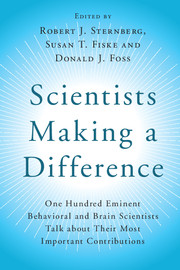 Scientists Making a Difference
Scientists Making a Difference Book contents
- Frontmatter
- Contents
- List of Contributors
- Foreword: Making a Creative Difference = Person × Environment
- Preface
- Part I Introduction
- Part II Biological Bases of Psychology: Genes, Brain, and Beyond
- Part III Cognition: Getting Information from the World and Dealing with It
- Part IV Development: How We Change Over Time
- Part V Motivation and Emotion: How We Feel and What We Do
- Section A Motivation
- 58 The Motivation for Creativity
- 59 Inner Processes Serve Interpersonal Functions
- 60 Self-Regulation
- 61 Intrinsic Motivation: The Inherent Tendency to Be Active
- 62 Mindsets: From the Classroom to the Middle East
- 63 Whether You Think You Can, or You Think You Can't – You're Right
- 64 Promotion and Prevention Motivations
- 65 The Letter to a Friend That Helped Launch a Career
- 66 The Empirical Study of Human Autonomy Using Self-Determination Theory
- 67 Behavioral Self-Regulation: A Little Optimism Goes a Long Way
- 68 The Affective Revolution of the 1980s
- Section B Emotion
- Part VI Social and Personality Processes: Who We Are and How We Interact
- Part VII Clinical and Health Psychology: Making Lives Better
- Part VIII Conclusion
- Afterword: Doing Psychology 24×7 and Why It Matters
- Index
- References
68 - The Affective Revolution of the 1980s
from Section A - Motivation
Published online by Cambridge University Press: 05 August 2016
- Frontmatter
- Contents
- List of Contributors
- Foreword: Making a Creative Difference = Person × Environment
- Preface
- Part I Introduction
- Part II Biological Bases of Psychology: Genes, Brain, and Beyond
- Part III Cognition: Getting Information from the World and Dealing with It
- Part IV Development: How We Change Over Time
- Part V Motivation and Emotion: How We Feel and What We Do
- Section A Motivation
- 58 The Motivation for Creativity
- 59 Inner Processes Serve Interpersonal Functions
- 60 Self-Regulation
- 61 Intrinsic Motivation: The Inherent Tendency to Be Active
- 62 Mindsets: From the Classroom to the Middle East
- 63 Whether You Think You Can, or You Think You Can't – You're Right
- 64 Promotion and Prevention Motivations
- 65 The Letter to a Friend That Helped Launch a Career
- 66 The Empirical Study of Human Autonomy Using Self-Determination Theory
- 67 Behavioral Self-Regulation: A Little Optimism Goes a Long Way
- 68 The Affective Revolution of the 1980s
- Section B Emotion
- Part VI Social and Personality Processes: Who We Are and How We Interact
- Part VII Clinical and Health Psychology: Making Lives Better
- Part VIII Conclusion
- Afterword: Doing Psychology 24×7 and Why It Matters
- Index
- References
Summary
I have conducted research on many different topics, including personality, psychopathology, life satisfaction and subjective well-being, mate preferences and marital satisfaction, sleep, organizational behavior, attitudes, and values. To make progress in each of these areas, researchers have had to answer two basic questions. First, what basic concepts (known formally as constructs) do we need to study? Second, how do we measure these constructs? My most important scientific contribution is that I played a key role in supplying plausible answers to both of these questions in the domain of affect, which is the area of science that examines moods, feelings, and emotions.
Development of the Model
How I Became an Affect Researcher
My work in this area arose from an improbable series of events. Early in my fourth year of graduate school at the University of Minnesota, I started dating Lee Anna Clark, who was a student in the Clinical Psychology program (I was in the much smaller Personality Research program). When it was clear that our relationship was becoming serious, she informed me that she recently had received a Fulbright International Fellowship to conduct her dissertation research in Japan the following academic year (1979–1980). We eventually decided that we would get married and I then would take a year off from graduate school and accompany her to Japan for her Fulbright year.
I scheduled a meeting with my graduate advisor, Auke Tellegen, to break the news to him. I had some trepidation about this, because I expected him to react negatively to the news. However, he actually was pleased, as he saw this as an opportunity to test the cross-cultural replicability of a model he had developed. Most mood/emotion researchers at that time emphasized the importance of specific, “discrete” affective states, such as fear, sadness, anger, joy, and attentiveness. In contrast, Auke had collected data indicating that emotional experience was dominated by two broad and non-specific dimensions, which he labeled Negative Affect (i.e., the non-specific tendency to experience aversive emotional states such as anxiety, depression, and hostility) and Positive Affect (i.e., the tendency to experience pleasurable and rewarding states such as happiness, enthusiasm, and alertness).
- Type
- Chapter
- Information
- Scientists Making a DifferenceOne Hundred Eminent Behavioral and Brain Scientists Talk about Their Most Important Contributions, pp. 320 - 324Publisher: Cambridge University PressPrint publication year: 2016
